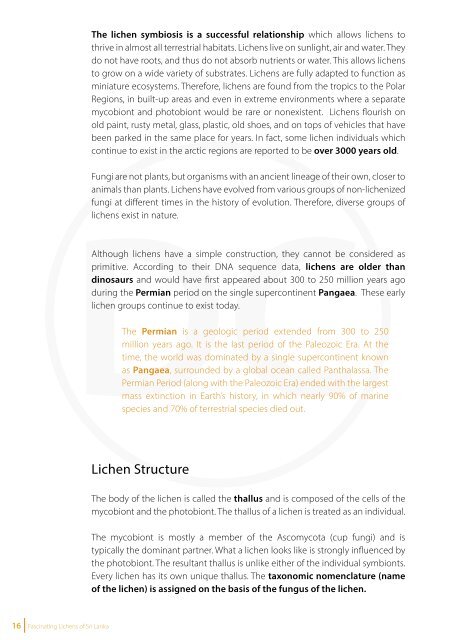You also want an ePaper? Increase the reach of your titles
YUMPU automatically turns print PDFs into web optimized ePapers that Google loves.
The lichen symbiosis is a successful relationship which allows lichens to<br />
thrive in almost all terrestrial habitats. <strong>Lichens</strong> live on sunlight, air and water. They<br />
do not have roots, and thus do not absorb nutrients or water. This allows lichens<br />
to grow on a wide variety <strong>of</strong> substrates. <strong>Lichens</strong> are fully adapted to function as<br />
miniature ecosystems. Therefore, lichens are found from the tropics to the Polar<br />
Regions, in built-up areas and even in extreme environments where a separate<br />
mycobiont and photobiont would be rare or nonexistent. <strong>Lichens</strong> flourish on<br />
old paint, rusty metal, glass, plastic, old shoes, and on tops <strong>of</strong> vehicles that have<br />
been parked in the same place for years. In fact, some lichen individuals which<br />
continue to exist in the arctic regions are reported to be over 3000 years old.<br />
Fungi are not plants, but organisms with an ancient lineage <strong>of</strong> their own, closer to<br />
animals than plants. <strong>Lichens</strong> have evolved from various groups <strong>of</strong> non-lichenized<br />
fungi at different times in the history <strong>of</strong> evolution. Therefore, diverse groups <strong>of</strong><br />
lichens exist in nature.<br />
The main body <strong>of</strong> the lichen, the thallus, consists mainly <strong>of</strong> microscopic threads<br />
<strong>of</strong> fungus, known as hyphae. In most lichens, the algal or cyanobacterial cells<br />
lie among the hyphae, in a layer just beneath the surface. The thallus usually<br />
consists <strong>of</strong> several distinct layers in many lichens;<br />
1. Upper Cortex - outermost layer: composed <strong>of</strong> densely packed fungal cells;<br />
<strong>of</strong>ten brightly coloured, containing pigments that protect the thallus from<br />
radiation. The cortex forms a sort <strong>of</strong> skin on the lichen’s surface.<br />
2. Algal Layer - concentration layer <strong>of</strong> photobiont cells, cells <strong>of</strong> algae and/or<br />
cyanobacteria.<br />
3. Medulla - loosely interwoven, thread like fungal cells (hyphae).<br />
4. Lower cortex - in some lichens root-like structures or rhizines, attach the<br />
thallus to the substrate.<br />
Upper cortex<br />
Although lichens have a simple construction, they cannot be considered as<br />
primitive. According to their DNA sequence data, lichens are older than<br />
dinosaurs and would have first appeared about 300 to 250 million years ago<br />
during the Permian period on the single supercontinent Pangaea. These early<br />
lichen groups continue to exist today.<br />
The Permian is a geologic period extended from 300 to 250<br />
million years ago. It is the last period <strong>of</strong> the Paleozoic Era. At the<br />
time, the world was dominated by a single supercontinent known<br />
as Pangaea, surrounded by a global ocean called Panthalassa. The<br />
Permian Period (along with the Paleozoic Era) ended with the largest<br />
mass extinction in Earth’s history, in which nearly 90% <strong>of</strong> marine<br />
species and 70% <strong>of</strong> terrestrial species died out.<br />
Cross section <strong>of</strong> the lichen thallus<br />
(Source: Indian lichens)<br />
Algal layer<br />
Fruiting body<br />
(apothecium)<br />
Medulla<br />
Lower cortex<br />
Thallus<br />
Rhizines on the thallus undersurface<br />
Lichen Structure<br />
The body <strong>of</strong> the lichen is called the thallus and is composed <strong>of</strong> the cells <strong>of</strong> the<br />
mycobiont and the photobiont. The thallus <strong>of</strong> a lichen is treated as an individual.<br />
The mycobiont is mostly a member <strong>of</strong> the Ascomycota (cup fungi) and is<br />
typically the dominant partner. What a lichen looks like is strongly influenced by<br />
the photobiont. The resultant thallus is unlike either <strong>of</strong> the individual symbionts.<br />
Every lichen has its own unique thallus. The taxonomic nomenclature (name<br />
<strong>of</strong> the lichen) is assigned on the basis <strong>of</strong> the fungus <strong>of</strong> the lichen.<br />
Apothecium<br />
Ascus with<br />
spores<br />
Algal cells<br />
Upper cortex<br />
<strong>of</strong> the thallus<br />
Lower cortex<br />
Rhizines<br />
(Above) Diagrammatic representation<br />
<strong>of</strong> a lichen, (Left) with a section<br />
through the thallus and apothecium<br />
Fungal hyphae<br />
(comprising the<br />
medulla)<br />
16 <strong>Fascinating</strong> <strong>Lichens</strong> <strong>of</strong> <strong>Sri</strong> <strong>Lanka</strong><br />
<strong>Fascinating</strong> <strong>Lichens</strong> <strong>of</strong> <strong>Sri</strong> <strong>Lanka</strong> 17















